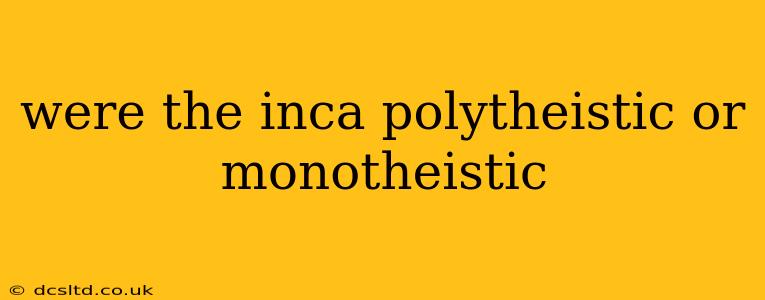The Inca religion is a fascinating and complex subject, often misunderstood as simply polytheistic or monotheistic. The reality is far more nuanced. While they worshipped a pantheon of gods and goddesses, their religious system exhibited characteristics that blur the lines between a strictly polytheistic and a strictly monotheistic structure. This exploration delves into the intricacies of Inca beliefs, addressing common questions and offering a clearer picture of their spiritual world.
What gods did the Inca worship?
The Inca pantheon was vast and varied, with deities representing natural forces, celestial bodies, and ancestral figures. Among the most prominent were:
- Inti: The sun god, considered the most important deity, was the focus of much Inca ritual and worship. He was seen as the source of life and energy.
- Viracocha: A creator god, often depicted as a bearded man, was believed to have created the world and humankind. His role is sometimes interpreted as a supreme being, further complicating the monotheism/polytheism debate.
- Mama Killa: The moon goddess, sister and wife of Inti, held significant importance in the agricultural calendar and cycles of life.
- Pachamama: Mother Earth, representing fertility and abundance, was revered and appeased through offerings.
- Illapa: The god of thunder and lightning, responsible for rain and storms.
Many other gods and goddesses were worshipped regionally, reflecting the diverse geography and cultural practices within the vast Inca Empire. Each had specific roles and associations, influencing various aspects of Inca life.
Did the Inca believe in a supreme being?
This is where the complexity of Inca religion becomes apparent. While they venerated a multitude of deities, the position of Viracocha suggests a belief in a supreme creator god. However, Viracocha's role wasn't one of constant intervention or direct worship in the same way as Inti. Viracocha's creation myth placed him at the origin of the world, but daily life and agricultural cycles were primarily directed towards Inti and other deities. This makes it difficult to definitively label their belief system as either strictly polytheistic or monotheistic. Some scholars argue for a hierarchical polytheism, with Viracocha at the apex.
Was Inti the only god?
No, Inti, while the most prominent and widely worshipped god, was not the only god in the Inca pantheon. The Inca religious system encompassed a complex hierarchy of deities, each with specific domains and responsibilities. The worship of Inti was central to the imperial ideology, tying the emperor's legitimacy to the sun's power, but it didn't negate the importance or existence of other gods.
How did Inca religion influence their society?
Inca religion deeply permeated all aspects of their society. Religious beliefs shaped their agriculture, social structure, political system, and daily life. Temples and shrines were built to honor the gods, and elaborate rituals and festivals were held to appease them and ensure a bountiful harvest. The emperor held a significant religious role, acting as an intermediary between the gods and the people. Religious practices served to strengthen social cohesion and maintain the empire's power.
Conclusion: A Nuanced Understanding
Labeling the Inca religion as solely polytheistic or monotheistic is an oversimplification. Their complex religious system featured a pantheon of gods, yet the presence of a creator deity like Viracocha introduces elements suggestive of monotheistic tendencies. Perhaps the most accurate description is a hierarchical polytheism, where a supreme being coexists with a multitude of other important deities, each with their own sphere of influence. Understanding this nuanced perspective allows for a richer appreciation of the Inca civilization and its rich spiritual tapestry.
